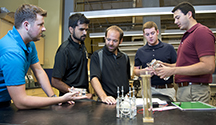Purdue students to design, build, fly spaceflight experiment to test green propellant
July 22, 2014
 |
|
Purdue students (from left) Ben Tackett, Siddharth Tripathi, Jordan Nykiel, Brian McGuire, and Andrew Melgar, are taking a Zero-Gravity Flight Experiment course, creating an experiment to study a new green propellant that could replace the traditional but highly toxic hydrazine fuel. (Purdue University photo/Mark Simons) |
WEST LAFAYETTE, Ind. – Students taking the Zero-Gravity Flight Experiment course at Purdue University will see their creation soar to the upper atmosphere to study a new green propellant, partnering with Aerojet Rocketdyne to demonstrate that the propellant can replace the traditional but highly toxic hydrazine fuel.
The students will design and build their experiment at Purdue and then NASA's Flight Opportunities Program will launch it on a commercial suborbital rocket flight. This type of launch allows testing of spaceflight technologies during minutes of weightlessness.
"Launching on a commercial suborbital rocket flight allows us to demonstrate spaceflight technology operations in weightlessness rapidly and relatively inexpensively," said professor Steven Collicott in Purdue's School of Aeronautics and Astronautics.
He has taught the course since 1996 to immerse undergraduate engineering students in the design-build-test cycle for zero-gravity experimentation in suborbital rocket flights, parabolic aircraft flights, and the Fluids Education payload for the International Space Station.
The experiment - the Purdue Green Propellant Suborbital Test (PGPST) - is designed to advance a green propellant to the next level of technology readiness. The low-toxicity propellant, developed by the U.S. Air Force Research Laboratory, is a hydroxyl ammonium nitrate fuel and oxidizer blend known as AF-M315E.
The rocket flight is a precursor to the NASA Green Propellant Infusion Mission (GPIM) being led by Ball Aerospace & Technologies Corp. as the prime contractor and principal investigator. The research builds on earlier collaboration by Purdue, Ball and Aerojet Rocketdyne and helps the STEM-education community engage in NASA's space technology mission and the emerging commercial space industry.
"One of the appealing things for us is that we know we get a good data product, but also that we know there will be valuable hands-on work for the students," said Joe Cassady, Aerojet Rocketdyne's executive director for space. "Supporting STEM is a big priority for our company."
Collicott said, "Discussions with alumni and friends at Ball Aerospace and Aerojet Rocketdyne showed that they would be interested in additional technology advancement work for this exciting new propellant."
The Purdue project tests the ability of traditional "surface-tension propellant management device" designs to properly control the propellant while in weightlessness. Such propellant management devices exploit surface tension and geometrical designs to cause propellant to wick into the proper positions in the propellant tanks when gravity is absent.
"Combining Purdue's zero-gravity experimentation expertise, Ball and Aerojet Rocketdyne's industry leadership, and commercial suborbital rocket flights offered through NASA's Flight Opportunities Program is a powerful blueprint for both technology advancement and teaching," Collicott said.
Media Contact: Emil Venere, 765-494-4709, venere@purdue.edu
Source: Steven Collicott, 765-494-2339, collicott@purdue.edu
